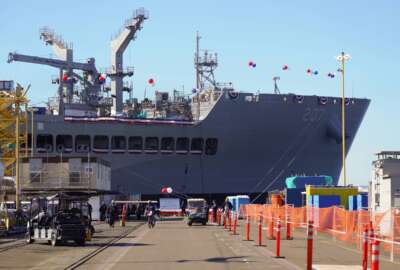On DoD: Air Force modernizes its bases through utility privatization
Air Force works to manage on-base utility costs through advanced metering initiative and privatization of aging infrastructure.
wfedstaff | April 18, 2015 1:50 am
DoD’s energy use is at its lowest level in at least 40 years, according to a report the Energy Information Administration released last month, citing updated electric grids and better energy metering on military bases as one factor that’s let the military lower its consumption.
In the case of the Air Force, one pathway toward a more modernized electric infrastructure has been to get out of the business of owning and operating utility systems altogether. In a similar vein to the military’s move to replace dilapidated on-base housing by outsourcing construction and management to private firms, the Air Force has decided that being a utility operator is not necessarily one of its core competencies.
“We recognize that we still have very important contingency capabilities that we need to maintain when it comes to providing utility service at a forward operating location, but we don’t necessarily need to maintain that capability at every single base,” David Bek, the director of the energy directorate at the Air Force Civil Engineer Center said during an appearance on Federal News Radio’s On DoD.
After a series of business case analyses at hundreds of bases, the Air Force has decided it made financial and operational sense to move forward with privatization of 66 electric, water and sewage systems so far, including one $400 million, 50-year contract for three systems in 2014. Bek said that one deal alone will save the Air Force $33 million over the life of the arrangement with the private operator.
“We think it’s a great deal from the taxpayer standpoint and it’s great news from the mission standpoint,” Bek said, “because the system owner will come in and maintain the system and bring it up to industry standard.”
Over the next two years, the Air Force plans to analyze 12 more systems and decide whether to retain them in government hands or contract them out to private operators.
As one other way to update utility infrastructure, the Air Force and the other military services have been working to gather more granular data on their on-base electric usage by adding more meters. Historically, some bases have had as few as one meter, measuring usage for the installation as a whole.
As part of the Advanced Meter Reading System (initiative), the Air Force is not only attaching meters to every building, but building a centralized, real- time reporting infrastructure so that base engineers can monitor which facilities are using the most energy, and when.
“It’s all with the intent of being able to collect data on at least 60 percent of the Air Force’s energy consumption,” Bek said. “So we’re presently planning to install the system on at least 30 bases over the next five years. At that point, we’ll do a business case analysis to determine whether there’s a financial benefit and a programmatic benefit to installing it at the rest of the installations.
But based on pilots projects at two bases so far, the prospects are promising. The Air Force plans to issue a contract later this year to install AMRS at five more sites.
“In the end, we think it will be a great tool for energy conservation, because it will put real-time information in the hands of base commanders so they can make conscious, deliberate decisions about their consumption patterns, ” Bek said. “They’ll be able to spread their load over the course of the day and manage their peaks, because their utility bill is already based on their peak consumption. I think it will also provide some historical information a few years down the road that will better help us understand where to target future energy conservation projects.”
RELATED STORIES:
DoD energy use falls to lowest level on record
Army changing its energy culture through better data
Army to trade land for renewable energy
Copyright © 2024 Federal News Network. All rights reserved. This website is not intended for users located within the European Economic Area.
Jared Serbu is deputy editor of Federal News Network and reports on the Defense Department’s contracting, legislative, workforce and IT issues.
Follow @jserbuWFED






